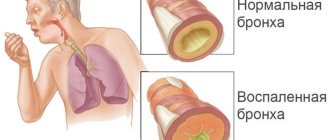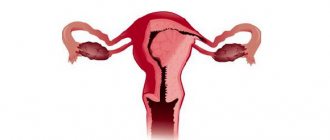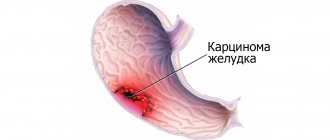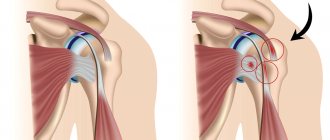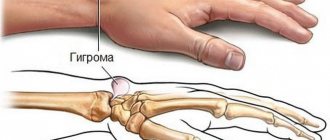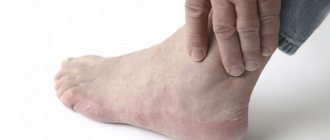Quite often you can get such damage, which is accompanied by impaired functionality in various joints without the occurrence of pronounced pain. In this case, the surfaces of the joints are shifted by a small distance while maintaining the points of contact.
This condition cannot even always be visually determined, since the swelling may be minimal and not accompanied by enlargement of the joint. Typically, pain effects manifest themselves in the subacute stage with periodic exacerbation to mild pain. Most often, subluxations occur in the ankle joint, while ruptures in the ligamentous tissues may not occur.
There are many reasons for habitual dislocation:
- Serious injury. This could be a fall from a height, a car accident, or a blow. It is traumatic exposure that is the cause in most cases;
- Sprain. This leads to the fact that they cease to perform a full supporting function;
- Muscle dystrophy. Similar to a sprain, the muscles lose their original tone, which causes the joints to become misaligned;
- Pathological structure of the head of the bone. This may also be a consequence of a previous injury;
- Too much physical activity, especially if it occurred during any rehabilitation period;
- Osteoarthritis. This disease is expressed in a weakening of the structure of the joints;
- Various inflammatory processes;
- Intrauterine pathology.
Habitual dislocation is more typical for males than for females.
It is noteworthy that young people are more likely to suffer from it.
Are there any dangerous consequences?
In the case when such an injury occurs and the necessary measures to eliminate the damage are not taken, a person may face quite long-term pain, which can be debilitating for the body and general emotional state.
Neurological disorders may occur over time . In addition, a complication may arise in the form of the development of certain pathologies of bone structures. This is especially true for subluxations in the cervical spine. As a result of the displacement of the vertebra, the load on a certain part of it changes, which leads to severe wear. The result will be the development of osteochondrosis, which in turn can provoke curvature of the entire spine, and then the pelvic region. Such changes can affect the operation of many internal systems.
Shoulder dislocation
A habitual shoulder dislocation involves the head of the bone coming out of the socket. Occurs in people who have previously suffered a traumatic dislocation of the shoulder and its reduction. With it, pain may be completely absent or mild in nature. There is no talk about acute pain that occurs during traumatic displacement of a joint. In addition, obvious symptoms include swelling in the affected area and difficulties in straightening the joint.
If the patient has previously encountered this phenomenon, then he will most likely understand that it is a shoulder dislocation . There is also a milder type of pathology called “joint instability.” In this case, the head of the humerus only partially emerges from the socket. The patient feels that the joint has taken on an unstable position.
Habitual shoulder dislocation
The more often the situation repeats, the more the structure of the joint itself is disrupted. If timely action is not taken, the patient will eventually experience the following symptoms:
- Constant aching pain. If you try to lift something heavy or perform physical exercises with your hands, they become more intense;
- When the shoulder joint is engaged, a characteristic crunch is heard;
- There is weakness in the hand. This is explained by the fact that the muscles in this area slowly undergo processes of dystrophy and atrophy;
- Limited hand movements.
A habitual dislocation is not difficult to set back, so many patients do it themselves.
Orthopedics and traumatology services at CELT
The administration of CELT JSC regularly updates the price list posted on the clinic’s website. However, in order to avoid possible misunderstandings, we ask you to clarify the cost of services by phone: +7
| Service name | Price in rubles |
| Appointment with a surgical doctor (primary, for complex programs) | 2 700 |
| Ultrasound of two symmetrical joints (except hip) | 4 000 |
| X-ray of bones and joints of the limbs | 2 200 |
| MR imaging of the shoulder joint | 7 000 |
All services
Make an appointment through the application or by calling +7 +7 We work every day:
- Monday—Friday: 8.00—20.00
- Saturday: 9.00–18.00
- Sunday: 9.00–17.00
The nearest metro and MCC stations to the clinic:
- Highway of Enthusiasts or Perovo
- Partisan
- Enthusiast Highway
Driving directions
Patella dislocation
After a traumatic dislocation of the patella, some patients develop habitual dislocation over time. Typically, patients at risk are those who:
- The elasticity of the ligaments is well expressed;
- The previously torn ligament did not heal well;
- The patella is too high.
For a habitual dislocation, the presence of some strong impact, for example, a fall or blow, is not necessary. It is likely that it can happen during everyday activities.
As in the case of the shoulder joint, this type of habitual dislocation is characterized by mild pain, only above the knee area. Sometimes there is no pain at all. Then the patient learns about the displacement of the joint by its unstable position.
As a rule, reducing a primary dislocation is not difficult, and most patients do it themselves at home. But here it is important to understand that it is still worth seeking advice from a doctor.
Otherwise, with frequent habitual dislocation, the surface of the joints will slowly but surely be damaged, which in the future can lead to very unpleasant consequences.
Subluxation of the first cervical vertebra
Slight displacement of the articular surfaces in the cervical region is also quite common. The first cervical vertebra is especially susceptible to subluxation.
Subluxation of the first cervical vertebra on x-ray
Such injuries most often occur there. This is due to the fact that its anatomical structure represents a special structure together with the odontoid process of the vertebra following it. This provides greater variety of motor activity, but increases vulnerability to injury. A common situation is that in case of subluxation of the first vertebra there are no pronounced symptoms, which results in an old injury.
Diagnostics
A traumatologist, orthopedist or surgeon can diagnose a habitual dislocation. The first step is to examine the patient, during which in most cases the doctor can more likely confirm that the joint has changed its location. But to complete the diagnosis, instrumental methods are still used, namely:
- Radiography. The picture clearly demonstrates the pathological position of the joint. For a more accurate result, the picture is taken in several projections;
- Computed and magnetic resonance imaging. These methods are suitable if it is necessary to evaluate the structure of the bone tissue itself, as well as the muscles located nearby. In addition, tomography is necessary in complex cases of dislocation when there are bone fragments;
- Arthroscopy. This is an endoscopic procedure that is performed using a special arthroscope apparatus. It is injected directly into the thickness of the joint, which makes it possible to assess its condition with high accuracy. The procedure is classified as minimally invasive and minimally traumatic. Arthroscopy is performed not so much to diagnose a dislocation as to identify its cause.
Habitual dislocation can be diagnosed using radiography.
All other diagnostic procedures are prescribed individually if necessary.
What to do
In case of any type of dislocation, the following steps must be taken:
- Provide the patient with a comfortable position;
- Secure the injured limb by applying a bandage or splint;
- Apply material soaked in cold water or ice to the injured area. Under no circumstances should you use warming ointments. Their use is indicated only after a day or two.
- Relieve pain with painkillers (analgin, ibuprofen, Nise, etc.);
- If there are bruises, treat the damaged area with an antiseptic (hydrogen peroxide or an alcohol-containing substance will do);
- Call an ambulance or arrange for the victim to be transported to the nearest medical facility.
Self-reduction of a dislocation without mastering special techniques is strictly prohibited. Even if the injury occurred in the presence of a person capable of reducing the dislocation, it is better to do this after a final examination and to exclude the possibility of more complex injuries.
Conservative treatment
This type of therapy can be prescribed to a patient who has had no more than 2-3 cases of habitual dislocation. Otherwise, you cannot do without surgery.
Treatment of habitual dislocation without surgery requires an integrated approach. Treatments prescribed may include:
- Therapeutic and manual massage. They not only relieve muscle tension, but also stimulate lymph and blood circulation in the area of dislocation;
- Physiotherapy. Regular performance of special exercises helps strengthen muscles and increase the elasticity of ligaments and tendons;
- Reflexology. Also known as acupuncture. Everyone knows that influencing certain points on the body can have a beneficial effect on the condition of the body and speed up the process of tissue regeneration;
- Physiotherapy. A very important component of conservative treatment. Physiotherapy procedures are prescribed to stimulate the restoration of damaged tissues and improve blood circulation.
Therapy can also be supplemented by taking medications of various types. As a rule, these are vitamin complexes, anticoagulants, and anti-inflammatory medications.
Surgical treatment
In most cases, surgical treatment is still performed. There are many different surgical techniques. The choice of the appropriate one is made based on what causes regular joint dislocation .
Habitual dislocation can be treated with surgery
In general, it is customary to divide 4 groups of operations:
- Aimed at strengthening ligaments and muscles;
- Aimed at changing the structure of the capsule;
- Aimed at installing implants and their parts;
- Combined. Combining elements of several types of operations at once.
Most often, surgery to dislocate the shoulder, patella or other areas is performed using the Bankart method. Its essence lies in the fact that the head of the bone is fixed by strengthening the cartilage and capsule. There are two options for performing the operation:
- Classic, in which soft tissue is cut with a scalpel. This method provides the surgeon with maximum possible access and visibility, but is also more traumatic. It is also worth noting the increased risk of blood loss and infection;
- Endoscopic. In this case, the surgeon makes two small incisions into which the necessary equipment is inserted. This operation is much easier for the patient to tolerate. As a rule, there is no need to stay in a hospital. The risk of bleeding and infection with the endoscopic form of intervention is minimal.
The rehabilitation period after surgery requires a responsible approach. Otherwise, relapse of the dislocation may occur. The area itself, in which there was complete surgical intervention, is immobilized using various devices: a plaster cast, splints, orthosis. After about a month, all supporting devices are removed, and the period of full development of the joint begins. To do this, the patient must attend physical therapy, therapeutic massage sessions and physiotherapy procedures.
The recovery time after surgery for a habitual dislocation varies in each individual case. But on average they vary from 4 to 8 months. This is influenced not only by the nature of the dislocation, but also by the characteristics of the patient’s body, such as age, the presence of chronic diseases, etc.
Possible complications
If in case of traumatic dislocation of joints, the most serious complications are bone fracture or damage to nerve endings and blood vessels, then in a repeated situation these risks are much lower. But, despite the fact that a habitual dislocation is almost not accompanied by pain and can be reduced quite easily, we should not forget that it can also lead to various kinds of complications.
Constant displacement of bone from the glenoid cavity can cause:
- Protrusion of the capsule;
- Destruction of bone tissue;
- Ligament and tendon rupture;
- Dystrophy or atrophy of muscles and ligaments.
Habitual dislocation can lead to destruction of bone tissue.
That is why, if repeated dislocation of a joint occurs, it is important not to ignore this process, but to seek medical help. Only a doctor, using diagnostic procedures, will be able to determine the exact cause of the pathology and prescribe treatment that will eliminate the problem.
First aid
It is important for each patient to understand that the sooner the joint is reset, the fewer complications will arise in the future, which is why doctors recommend performing the procedure within two hours after the injury. If an ankle injury occurs, you should immediately call an ambulance, and while the doctors are on their way, follow the following first aid recommendations:
Read also: How to straighten the elbow joint
- Completely immobilize the limb; if the decision was made to go to the hospital on your own, you need to ensure complete rest for the sore leg. To do this, you need to carefully lay it on the board and wrap it loosely with a bandage or clean cloth; if there is a wound and bleeding, you need to apply a tourniquet. The patient must be carefully moved into the vehicle, placing the leg so that it is immobilized; the patient must be driven as carefully as possible.
- To relieve pain and reduce swelling, you can apply ice to the sore area. A piece of frozen meat or a bag of vegetables is suitable for this. Ice should be wrapped in a towel and applied to the sore spot for 15-20 minutes; frostbite or hypothermia must not be allowed to occur, so applying ice without a cloth is prohibited.
It is not recommended to adjust the ankle joint on your own; this can be very dangerous, since the disease is often accompanied by fractures. Even doctors do not set joints for fractures. Also, do not delay the trip to the hospital; if the joint is not corrected in the first hours, the swelling will grow and most likely it will have to be corrected surgically.
It is important to note that rehabilitation after surgery takes longer, the risk of infection also increases, and a scar will likely remain on the leg. By going to the hospital with a dislocation in the first hours, a person guarantees a quick recovery without consequences.
Prevention
In order to prevent re-dislocation , it is necessary to follow a number of preventive measures. Preventive therapy includes:
- Wearing special bandages and restraints;
- Control over the amount of physical activity;
- Avoidance of excess weight;
- Maintaining a balanced diet rich in minerals and vitamins;
- Regular preventive examination;
- Wearing comfortable shoes when it comes to the joint of the lower limb.
In addition, all instructions of the attending physician must be followed. Only in this case can we hope that the joint will not dislocate again.
